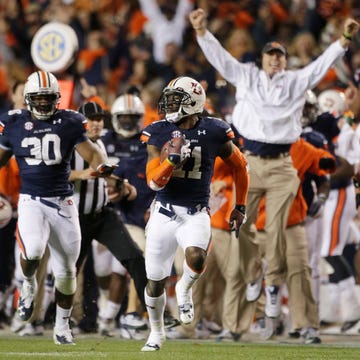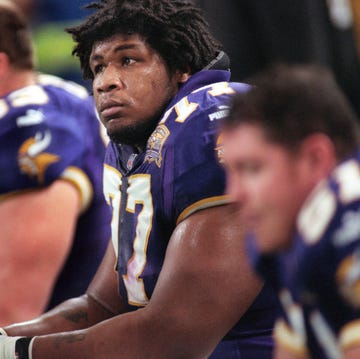Ever wanted a new sport to get into? Perhaps one that combines adrenaline, high-tech thrills and spills, and exotic locations? SailGP might be for you. Think of it as Formula 1 on water, with ten nations battling it out in 50-foot-long, 80-foot-tall high-tech racing catamarans powered entirely by the wind. But here’s the thing: They don’t sail. They fly—and fast.
SailGP, founded in 2019, is the brainchild of billionaire sailing nut Larry Ellison and New Zealander Sir Russell Coutts, arguably the most famous and successful competitive sailor in the sport’s history. From the get-go, the pair’s idea was not to create just another race series for yachty insiders but a global, spectator-friendly event that could capitalize on the new advances in sail racing afforded by foiling technology. This year, the season reached 193 million viewers, up 48 percent from 2023. Taking more than a little inspiration from Formula 1, SailGP set out to attract non-sailors to this burgeoning sport, partly by staging the races in nontraditional waters, like Abu Dhabi, Bermuda, and Halifax, Nova Scotia.
Since its inception, the SailGP competition has been sponsored by Rolex, which has long been a supporter of all manner of sailing. Last year, the brand extended its support by ten more years. As well as a $2 million purse for his team, the winning skipper at the grand finale, which this season took place below the Golden Gate Bridge in San Francisco, receives a titanium Yacht-Master II.
Many of sailing’s luminaries are also key members of Rolex’s Testimonee program, evangelizing for both sailing and its unique connection with ocean sustainability. One of them is Tom Slingsby, helm and CEO of SailGP’s Team Australia and three-time Rolex Sailor of the Year. At the top of his game, Slingsby, 39, has carried off three of the four SailGP championships for Team Australia since it began in 2019.
Foiling, just a decade-and-change old, has transformed competitive sailing. Put simply, thanks to the physics of hydrostatic pressure, by sailing on carbon-fiber blades, an entire 50-foot racing catamaran can lift itself out of the water, reducing the drag coefficient to almost nothing and producing speeds unimaginable just 15 years ago. Often this means the boat moves three, even four times faster than the wind.
“You see spectators’ faces when you go past them doing nearly 100 kilometers an hour on the water and at four times the wind speed,” Slingsby says. “It’s unbelievable.” Foiling has almost doubled competitive sailing’s top speed—and it’s getting faster all the time. Not that speed is really the aim here.
“I don’t think it’s SailGP’s goal to set an outright speed record or anything like that,” Slingsby explains. “What we want is a good racing product. Our hydrofoils don’t need to just go super fast in a straight line; they need to go around a racetrack efficiently, to take off in light airs and sail well in strong airs, and be maneuverable when tacking and jibing.”
But getting there requires both skill and experience in a fast-evolving sport, as well as an array of technology and data gathering. So called “aviation officers” on each team have one job: to keep the race boat flying on its foils in constantly changing conditions. When they don’t, interesting things can happen.
Slingsby will probably race any boat you put in front of him. There’s a reason for that. “In the Olympics in 2008,” he says, “I went in as a favorite to win the Laser gold medal and I choked—basically I finished 22nd. Then my good friend Nathan Outteridge [a fellow Australian and helm of SailGP Team Switzerland] was leading going into the final race and ended up coming away with fifth and missing a medal. We were both really depressed. We were sitting having a beer after the Olympics and he said, ‘We’ve just got to sail more. Let’s just sail every type of boat, learn every type of skill, and that way we will be hard to beat.’”
Slingsby (and Outteridge) did just that, diving headfirst into the nascent sport of foiling at just the right time. Both went on to win Olympic golds.
“I’m very fortunate that I actually got to be part of sailing before foiling came along,” Slingsby says. “I went to the Olympics in Lasers, probably the simplest boat in the world, and then I was there when the America’s Cup boats started hydrofoiling. Now I’m here now with SailGP, the fastest and most amazing foiling league in the world, and it’s really taking our sport to new levels.”
Unlike Formula 1, there’s a deliberately bare-bones vibe to the infrastructure of SailGP to make the whole competition as environmentally sustainable as possible. The tagline is, after all, “Powered by Nature.”
“SailGP is at the top of the sport,” Slingsby explains, “so it filters down through the whole of sailing. We see and deal with ocean health every day; we see it much more than, say, tennis players do, or F1 drivers, or track athletes. We’re out there dealing with Mother Nature; it’s probably just us and surfers. It’s our responsibility to raise awareness.”
Off the water, the Impact Awards challenge GP teams to come up with ingenious ways to reduce waste and save on resources. For instance, the race catamarans—which all have the same design—were designed so they can be disassembled and fit into a single 40-foot container.
The benefit of one-design racing is that it levels the playing field. Skill becomes much more pivotal. Each boat has around 160 electronic sensors, tracking every setting of the boat, especially below the waterline, where the angle of attack of the foils is critical. Win or lose, at the end of a race day, all those recorded settings are beamed straight to the cloud and are immediately accessible to the other teams and their tacticians.
“Initially, I really didn’t like it,” says Slingsby of the data sharing. “We were the top team, and every day we’d go out and be losing advantage to our competitors because they would see our data from that day, and they were getting closer and closer. But now, I think it’s just good for SailGP. The racing is so much tighter.”
Tighter, but also more human. While material failures account for a proportion of crashes, decisions made by a skipper in a split second—or simply a split second too late—can throw out a whole race.
Another curiosity of SailGP is the way the finals are set up. The point system gives the race winner ten points, second place receives nine points, and so on. But the finals are where it gets interesting. The grand-finale weekend consists of five qualifying fleet races featuring all ten teams, and then the final race itself. Only the top three teams get to race in the final, with their seasonal scores effectively erased. Which means a team could be third overall for the season and still win the grand finale in the last few minutes of the season. It makes for a gripping race.
That’s precisely what happened last month in San Francisco, where third-place Spain, skippered by Diego Botin, edged out league leaders New Zealand and Australia in a race that lasted just ten minutes.
Slingsby, for his part, is currently in Barcelona, where that other great sailing race, the America’s Cup, is underway. SailGP’s 2024-25 season kicks off in November in Dubai. Two new teams are rumored to be joining the fray, attracted by the unique approach to racing established for SailGP.
“The America’s Cup is a development game,” says Slingsby. “You design your own boat and you’re just trying to make it the fastest you possibly can on the water. Essentially, you’re in training boats for three years and then you get three or four months in your actual race boat. You really do one important event in four years. With SailGP, we get to race for a full season every year. So for sure, SailGP is my favorite thing to do, because it’s consistent racing every month. Me, I’m a racer.”
Nick Sullivan is Creative Director at Esquire, where he served as Fashion Director from 2004 until 2019. Prior to that, he relocated from London with his young family to Boerum Hill, Brooklyn. He has styled and art directed countless fashion and cover stories for both Esquire and Big Black Book (which he helped found in 2006) in exotic,uncomfortable, and occasionally unfeasibly cold locations. He also writes extensively about men’s style, accessories, and watches. He describes his style as elegantly disheveled.

















